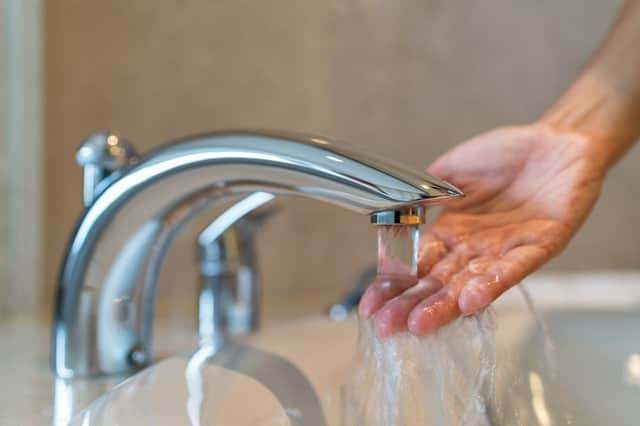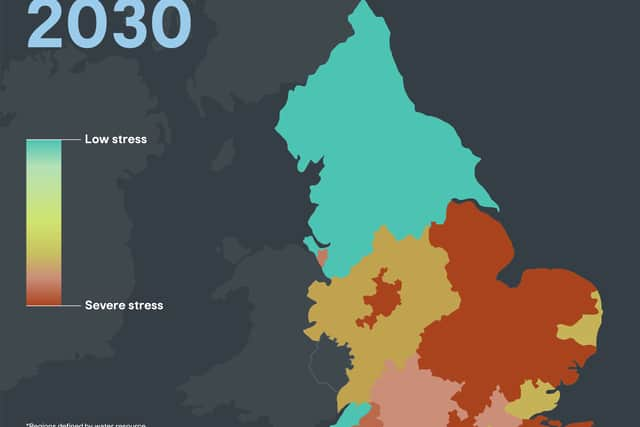UK homes use more than twice as much water than they realise


Homes in the UK are using more than twice as much water than they realise when showering, flushing the toilet and running the tap, according to research. A study of 3,000 adults found the average person estimates they use 57 litres a day, when in reality, it’s 144 litres - equivalent to more than four large wheelie bins worth of water a week.
People shower for an average of around eight minutes a day, which uses up to a staggering 96 litres of water. Four in ten respondents run their dishwasher when it is not fully loaded, rising to six in ten Londoners (61 per cent).
Advertisement
Hide AdAdvertisement
Hide AdMore than half admit to leaving the tap on while brushing their teeth - with a running tap - using six litres on average every minute. And 54 per cent suspect they waste water in their homes without realising it, with bathrooms, kitchens and gardens accounting for the most water usage.
Further research from B&Q and Screwfix owner Kingfisher, in partnership with economics consultancy Cebr, has found that by 2030, seven regions out of a total of 17 in England are set to be severely water stressed - meaning there may not be enough water to meet local demand.
The West Midlands, London, parts of the South West, the East Midlands, the East of England, and the South East are all regions expected to be severely impacted. Regions in the South of England are expected to be the worst affected, while the North West, the North East and Yorkshire & the Humber will be less vulnerable.
By 2040, the number of seriously water stressed regions is on course to rise to 12. The year 2040 is when the Environment Agency has warned that England risks running short of water.
Advertisement
Hide AdAdvertisement
Hide Ad

Thierry Garnier, CEO of Kingfisher, said: “Across Europe, we are experiencing more extreme weather, leading to increasing water scarcity in many regions. As the impact of climate change becomes more apparent, measures such as hose pipe bans are set to become much more common, with increasingly strong measures needed to reduce demand.
“We all have a role to play in conserving water. Making simple and affordable changes in our homes can have a huge impact, from installing water butts to collect rainwater for the garden to fitting tap aerators or low-flow shower heads.
“Governments can also help by encouraging the rollout of smart water meters and supporting the public to be more informed about water. By taking action now, we can put our water usage on a more sustainable path and safeguard this essential resource for the future.”
Despite a huge number of people underestimating how much water they use in their home, 79 per cent of Brits said reducing the amount of water they use is important to them. However, more than half (53 per cent) wish they had more information on how to save water.
Advertisement
Hide AdAdvertisement
Hide AdMany Brits have already started to make changes to their homes to save H2O. The most popular measures include installing water efficient toilets (31 per cent), purchasing a water butt (26 per cent), fitting low flow shower heads (18 per cent) and using mulch or bark chips on garden beds (13 per cent).
Less than a third (31 per cent) said they have not taken any water saving measures in their home, according to the OnePoll.com figures.
Kingfisher’s top tips to reduce your water usage
BATHROOM
- Shorten your showers – reducing your shower from eight minutes to five can save up to 30 litres of water.
- Turn off the tap – a running tap wastes approximately 6 litres per minute.
- Upgrade your toilet – consider switching to a dual flush toilet, with two buttons allowing different quantities of water to flow. The lower flush option typically saves up 4-6 litres of water per flush. Alternatively, try installing a cistern displacement device in your toilet – these can save up to 5,000 litres of water a year and are often available free of charge from your water company.
- Install low flow shower heads – these can save up to 60 litres of water per shower.
- Fit a tap aerator – this small, simple device mixes water with air, reducing the flow but maintaining the water pressure. They are cheap and easy to install and can save significant amounts of water.
KITCHEN
- Fill it up - make sure your dishwasher or washing machine is fully loaded so that you make the most of the water being used. Avoiding pre-rinsing dishes can also help to reduce water waste.
- Use a washing up bowl – if washing up by hand, use a washing up bowl rather than continuously running the tap.
- Upgrade to a water-saving tap – taps designed to be water efficient can use up to 40 per cent less water than a normal tap.
GARDEN
- Install a water butt – collecting and storing rainwater to use in your garden is a great way to conserve water while keeping your garden well-maintained.
- Use a watering can – use a watering can wherever you can for more targeted watering. Watering the garden with a hosepipe can use 1,000 litres of water an hour – more than 12 baths. If you are using a hosepipe, attaching a trigger nozzle will halve the amount of water used and help direct the flow to the root of your plants.
- Pick drought-resistant plants – consciously choosing plants that need less water, such as lavender or poppies, means you can more easily keep them healthy during dry summer months.
- Reduce evaporation – using mulch and bark in your garden will help to reduce water evaporation by up to 75 per cent. Minimise evaporation by watering in the early morning or late evening, allowing the water to soak into the soil and reach plant roots.